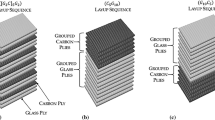Abstract
We describe the effect of the stacking sequence on the distribution of the deformation and stress fields through the thickness of the laminate. The laminates are made of epoxy resin and glass fibres, having the ratio of 0 to 90° plies equal to 1. This stacking sequence is applied to obtain composite laminates with different thicknesses. The study presented in this paper is focused on the linear static behavior of the cross-ply laminates by means of finite-element models developed using the commercial codes ANSYS 6.1 and LUSAS 15.3. The numerical models represent three-point bending loading cases. A viscoelastic analysis of the laminates based on the correspondence principle is also performed. The results from the finite-element models show good agreement with those obtained using the classical laminate theory, while the viscoelastic storage modulus and loss factors’ distribution indicate the optimal stacking sequences for structural dynamics applications, such as spring leaves for novel car suspension systems.
Similar content being viewed by others
References
M. Avalle and G. Belingardi, “A theoretical approach to the optimization of flexural stiffness of symmetric laminates,” Compos. Struct., 31, 75–86 (1995).
H. Chalaye, “Les matériaux composites. Dynamisme et innovation. SESSI, service de la direction générale de l’industrie, des technologies de l’information et des postes (DiGITIP),” Les 4 pages des statistiques industrielles, No. 158 (février 2002).
A. Bezazi, A. El Mahi., J.-M. Berthelot, et B. Bezzazi, “Analyse de l’endommagement des stratifiés en flexion 3-points. Influence de la séquence d’empilement,” XVème Congrès Français de Mécanique (Nancy, 3–7 septembre) (2001).
A. Bezazi, A. El Mahi, J.-M. Berthelot, and B. Bezzazi, “Flexural fatigue behavior of cross-ply laminates: An experimental approach,” Strength Mater., 35, No. 2, 149–161 (2003).
A. Bezazi, A. El Mahi, J.-M. Berthelot, and A. Kondratas, “Investigation of cross-ply laminates behavior in three-point bending tests. Part II: Cyclic fatigue tests,” Mat. Sci., 9, No. 1, 128–133 (2003).
B. D. Davidson, R. Kruige, and M. Konig, “Three-dimensional analysis of center-delaminated unidirectional and multidirectional single-leg bending specimens, Compos. Sci. Technol., 54, 385–394 (1995).
C. T. Sun and K. C. Jen, “On the effect of matrix cracks on laminate strength,” J. Reinf. Plast. Comp., 6, 208–223 (1987).
A. El Mahi, J.-M. Berthelot, and J. Brillaud, “Stiffness reduction and energy release rate of cross-ply laminates during fatigue tests,” Compos. Struct., 30, Issue 2, 123–130 (1995).
L.-R. Tsau and C.-H. Liu, “A comparison between two optimisation methods on the stacking sequence of fibres-reinforced composite laminate,” Compos. Struct., 55, Issue 3, 515–525 (1995).
J.-H. Park, J.-H. Hwang, C.-S. Lee, and W. Hwang, “Stacking sequence of composite laminates for maximum strength using genetic algorithms,” Compos. Struct., 52, Issue 2, 217–231 (2001).
S. W. Tsai and H. T. Hahn, Introduction to Composite Materials, Technomic Publishing Co., Inc. Lancaster Basel (1980).
J.-M. Berthelot, Composite Materials. Mechanical Behavior and Structural Analysis, Springer, New York (1999).
Z. Hashin, “Complex modulus of viscoelastic composites. II. Fiber reinforced material,” Int. J. Solids Struct., 6, 797–807 (1970).
R. B. Adams and D. C. G. Bacon, “Effect of fiber orientation and laminate geometry on the dynamic properties of CFRP,” J. Compos. Mater., 7, 402–408 (1973).
J.-M. Berthelot and Y. Sefrani, “Dam** analysis of unidirectional glass and Kevlar composites,” Compos. Sci. Technol., 64, 1–18 (2004).
Author information
Authors and Affiliations
Additional information
__________
Translated from Problemy Prochnosti, No. 3, pp. 134–146, May–June, 2007.
Rights and permissions
About this article
Cite this article
Harkati, E.H., Bezazi, A., Guenfoud, M. et al. Stacking layer sequence effects for glass fibre/epoxy resin cross-ply laminates. Strength Mater 39, 320–330 (2007). https://doi.org/10.1007/s11223-007-0036-y
Received:
Issue Date:
DOI: https://doi.org/10.1007/s11223-007-0036-y




